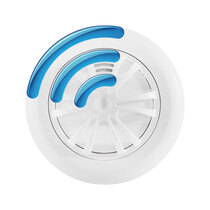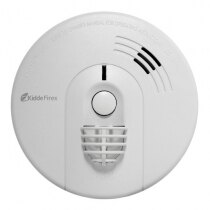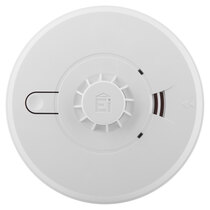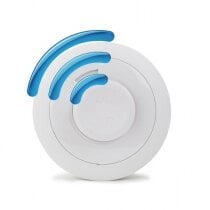-
Contact
Sales & Customer Service
0800 612 6537 support@safelincs.co.uk Live ChatDelivery Enquiries
0800 077 6149 - Resources
Fire & Safety Solutions
CALL OUR TEAM NOW 0800 612 6537
Lines open today 8am - 6pm
FREE Delivery
on marked products
Live Chat - Online
Instant help & Advice
Trade Discounts
and exclusive pricing
0% Credit Available
Open an account now
5 Star Customer Feedback
Heat Alarms
Heat alarms are designed for installation in smoky or dusty environments such as kitchens or garages, as they will not 'false alarm' due to cooking fumes or emissions from a car exhaust. Heat alarms work by detecting a rise in temperature rather than smoke particles in the atmosphere. Some heat alarms even measure the speed of the temperature rise.
We also offer a heat alarm specifically designed to monitor the area above a cooker to detect if an oven ring has been left on or a pan dries out (Stove Guard).
Radio-Interlinked 10 Year Sealed Battery Heat Alarm - UltraFire ULLH10RF
The UltraFire ULLH10RF features a sealed 10 year battery and wireless interlink with up to 15 total alarms to alert the whole house of a possible fire emergency. Ideal for kitchens, garages, basements, and lofts.
- Battery: 10 year sealed lithium battery
- Warranty: 10 year manufacturer's warranty
- Heat sensor suitable for kitchens and garages
- Wireless interlink up to 15 total alarms
Battery Heat Alarm - UltraFire UBH1
- FREE delivery
- Battery: AA alkaline batteries (included)
- Warranty: 10 year warranty
- Large test and hush button
- Suitable for BS 5839-6: 2019 Grade F2 installations
- Kitemarked to BS 5446-2: 2003
Battery Smoke Alarms and Heat Alarm Home Essentials Kit - UltraFire UFUB1KIT
- FREE delivery
- Battery: Alkaline batteries (included)
- Warranty: 10 year warranty
- Large test and hush button
- 2 x optical smoke alarms and 1 x heat alarm included
- Suitable for BS 5839-6: 2019 Grade F2 installations
- CE marked
10 Year Longlife Battery Heat Alarm - UltraFire ULLH10
Ideal for rooms like garages, kitchens, and lofts where dust or fumes would cause false activations of smoke alarms, the UltraFire ULLH10 features a sealed 10 year battery and 10 year manufacturer's warranty.
- Battery: 10 year sealed lithium battery
- Warranty: 10 year manufacturer's warranty
- Heat sensor suitable for kitchens and garages
Radio-Interlinked Battery Powered Heat Alarm - UltraFire UBH1RF
- Battery: AA alkaline batteries (included)
- Warranty: 10 year warranty
- Large test and hush button
- Wireless interlink up to 50 compatible alarms
- Range of up to 35m in buildings
- Suitable for BS 5839-6: 2019 Grade F2 installations
- Certified to BS 5446-2: 2003
10 Year Sealed Lithium Battery RF-LINK Heat Alarm - Firehawk FHH10-RF
- Detector Battery: 10 year sealed lithium battery
- Wireless Base Battery: 7 year sealed lithium
- Warranty: 7 year manufacturer's warranty
- Radio-interlink up to 20 Firehawk RF-LINK smoke, heat, carbon monoxide, and hard of hearing alarms
- Also suitable for the 2022 Scottish legislation
Radio-Interlinked Smoke Alarms and Heat Alarm Home Essentials Kit - UltraFire UFUB1RFKIT
- Battery powered with AA alkaline batteries
- Warranty: 10 year warranty
- Large test & hush button
- Wirelessly interlink up to 50 UltraFire UB1RF series alarms
- 2 x optical smoke alarms and 1 x heat alarm included
- Suitable for BS 5839-6: 2019 Grade F2 installations
Mains Powered Heat Alarm with Alkaline Back-up Battery - FireAngel HW1-R
- Power: 230V mains powered with back-up battery
- Backup Battery: 9V alkaline battery
- Warranty: 5 year warranty
- Thermistor heat sensor measures the ambient temperature of the air
- Interlinks with up to 12 FireAngel W1 mains powered alarms
- Dedicated Test and Silence buttons
- Suitable for BS 5839-6: 2019 Grade D2
- Kitemarked to BS 5446-2: 2003
- Also suitable for both the Welsh and Scottish 2022 legislation
Mains Powered Heat Alarm with Back-Up Battery - Kidde Firex KF30
- Power: 230V mains powered with battery backup
- Backup: Optional alkaline or self-charging lithium backup battery versions
- Warranty: 6 year warranty
- Test and hush buttons
- Neat slimline design
- Interlinks with up to 24 units
- Suitable for BS 5839-6: 2019 Grade D1 or D2
- Kitemarked to BS 5446-2: 2003
- Also suitable for both the Welsh and Scottish 2022 legislation
Mains Powered Heat Alarm with Alkaline Back-up Battery - Aico Ei144e
- Power: 230V mains powered with back-up battery
- Backup Battery: 9V alkaline backup battery (included)
- Warranty: 5 year warranty
- Test and hush buttons
- Interlinks with up to 12 units
- Kitemarked to BS 5446-2: 2003
- Also suitable for both the Welsh and Scottish 2022 legislation
Mains Powered Heat Alarm with Self-Charging 10 Year Back-up Battery - Aico Ei3014
- Mains powered heat alarm with sealed lithium back-up battery
- SmartLINK compatible when used with Ei3000MRF
- Hardwire interlink with up to 12 compatible devices
- Suitable for BS 5839-6: 2019 Grade D1 installations
- Available in Optical, Carbon Monoxide, Heat & Carbon Monoxide and Optical & Heat
- Also suitable for the 2022 Scottish legislation
Mains Powered Combined Optical Smoke and Heat Alarm with Self-Charging 10 Year Back-up Battery - Aico Ei3024
- Power: 230V mains powered with lifetime back-up battery
- Backup Battery: Self-charging battery
- Warranty: 5 year warranty
- Multi-sensor alarm containing both an optical and heat sensor
- Hardwire interlink with up to 12 compatible devices
- Extract real time data to your smart phone
- Kitemarked to BS EN 14604: 2005 (smoke)
- Kitemarked to BS 5446-2: 2003 (heat)
- Also suitable for both the Welsh and Scottish 2022 legislation
Mains Radio-Interlinked Heat Alarm with Sealed Longlife Back-up Battery - FireAngel Pro Connected FP1740W2-R
- Power: 230V mains powered with lifetime back-up battery
- Back-up Battery: Built-in, lasts the lifetime of your alarm
- Warranty: 5 year warranty
- Can interlink with up to 50 Wi-Safe 2 compatible devices
- Range of up to 35m in buildings
- Suitable for BS 5839-6: 2019 Grade D1 installations
- Kitemarked to EN 5446-2: 2003
- Also suitable for both the Welsh and Scottish 2022 legislation
Mains Powered Combined Heat and Carbon Monoxide Alarm with Self-Charging 10 Year Back-up Battery - Aico Ei3028
- Product Lifespan: 10 years
- Power: 230V mains powered with battery backup
- Backup Battery: Re-chargeable lithium battery
- Warranty: 5 year warranty
- Hardwire interlink with up to 12 compatible devices
- Compatible with Ei3000MRF SmartLINK module
- Kitemarked to BS EN 50291-1: 2010 (CO gas)
- Kitemarked to BS 5446-2: 2003 (heat)
- Suitable for ceiling installation
- Also suitable for both the Welsh and Scottish 2022 legislation
Kitchen Stove Guard - Firechief FSW1
- Power: 230-400V (Control Unit) and CR2032 Battery (Heat Sensor)
- Warranty: 2 year warranty
- Designed for easy installation on electric cookers
- Helps prevent cookers fires from starting with heat sensing technology
- Control unit cuts off the electricity supply to the cooker when triggered
- Fulfils requirements of Stove Guard Standard EN 50615
10 Year Longlife Battery Radio-Interlinked Heat Alarm - Aico Ei603RF
- Battery: Built-in, lasts the lifetime of your alarm
- Warranty: 5 year warranty
- Radio-interlinked heat alarm
- Built-in RadioLINK+ repeater function
- Self-tests every 16 seconds
- Twist-on base design for simple installation
- Suitable for BS 5839-6: 2019 Grade F1
- Kitemarked to BS 5446-2: 2003
- Also suitable for the 2022 Scottish legislation
Radio-Interlinked Sealed Battery 3 Smoke Alarms and 1 Heat Alarm Kit - Hispec RF10-PRO Range
- Battery: 10 year sealed lithium battery
- Warranty: 5 year warranty
- Wirelessly interlink up to 20 Hispec RF10-PRO devices
- Suitable for BS 5839-6: 2019 Grade F1 installations
- Compatible with the Hispec Control Unit and Carbon Monoxide Alarm
- Also suitable for the 2022 Scottish legislation
Mains Powered Heat Alarm with Alkaline Back-up Battery - Firehawk FHN450BB
This Firehawk FHN450BB mains powered heat alarm features replaceable alkaline battery backup, and interlinks with other 250BB/RB smoke and 450BB/RB heat alarms in the FHN range.
- 230V mains with AAA alkaline battery backup
- 6 years manufacturer's warranty
- Hardwire interlink up to 12 Firehawk FHN smoke and heat alarms
- UKCA marked, CE marked, and Kitemarked
- Also suitable for both the Welsh and Scottish 2022 legislation
Mains Heat Alarm with Sealed Self-Charging Lithium Battery Backup - Firehawk FHN450RB
- Power: 230V mains powered with back-up battery
- Back-up Battery: sealed self-charging lithium battery
- Warranty: 10 year warranty
- Interlinks with up to 15 Firehawk FHN250 and FHN450 alarms
- Combined test and silence button
- Fast-Fix bases for easy installations
- Suitable for BS 5839-6: 2019 Grade D1
- Kitemarked to BS 5446-2: 2003
- Also suitable for both the Welsh and Scottish 2022 legislation
10 Year Longlife Battery Radio-Interlinked Heat Alarm - FireAngel Pro Connected FP1720W2-R
- Battery: Built-in, lasts the lifetime of your alarm – GUARANTEED
- Warranty: 5 year warranty
- Can interlink with up to 50 Wi-Safe 2 compatible devices
- Large central button for test, hush and locate
- Range of up to 35m in buildings
- Suitable for BS 5839-6: 2019 Grade F1 installations
- Kitemarked to BS 5446-2: 2003
- Also suitable for the 2022 Scottish legislation
Page 1 (20 of 34 Products)
Do I Need a Heat Alarm or Smoke Alarm?
How do Heat Alarms work?
Where do you put a Heat Alarm?
Do I Need a Heat Alarm or Smoke Alarm?
Heat alarms are recommended for installing in kitchens and garages, where smoke or cooking fumes could cause false alarms in traditional smoke alarms. Heat alarms detect heat, rather than smoke, which makes them ideal for areas where dust, steam, and 'normal' smoke fumes (such as during cooking) are present, and would ordinarily cause a smoke alarm to falsely activate.
Smoke alarms are recommended for installing in most rooms of the house, including bedrooms, living rooms, and hallways (general living areas). Optical smoke alarms are designed to quickly detect smoke from all sources, and are also able to detect smoke from slower, smouldering fires.
How do Heat Alarms work?
Heat alarms work by detecting a rise in temperature, rather than detecting smoke particles in the atmosphere like traditional smoke alarms. This is why they are most suited to areas where smoke alarms falsely activate. Most commonly, these areas include kitchens and garages. For more accurate detection, some heat alarms also measure the rate at which temperature rises so they can provide an earlier warning of danger.
Where do you put a Heat Alarm?
Heat Alarms can be installed in areas where traditional smoke alarms would falsely activate due to 'normal' smoke fumes (such as during cooking), vapours, dust, and damp. Heat alarms are recommended for kitchens and garages. Always refer to the manufacturer's instructions for your alarm for detailed alarm placement guidance.
Compare (0)
Reset







































